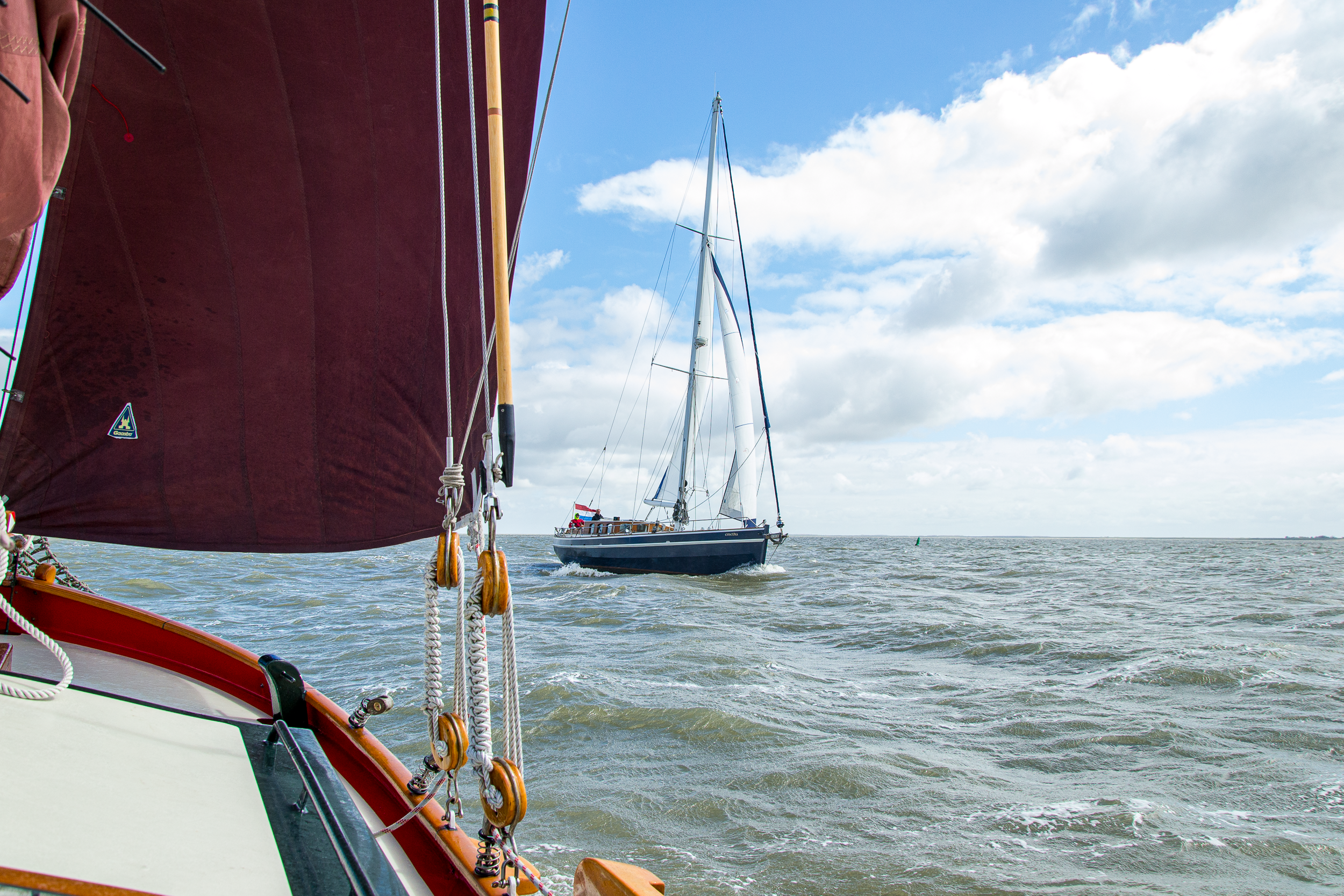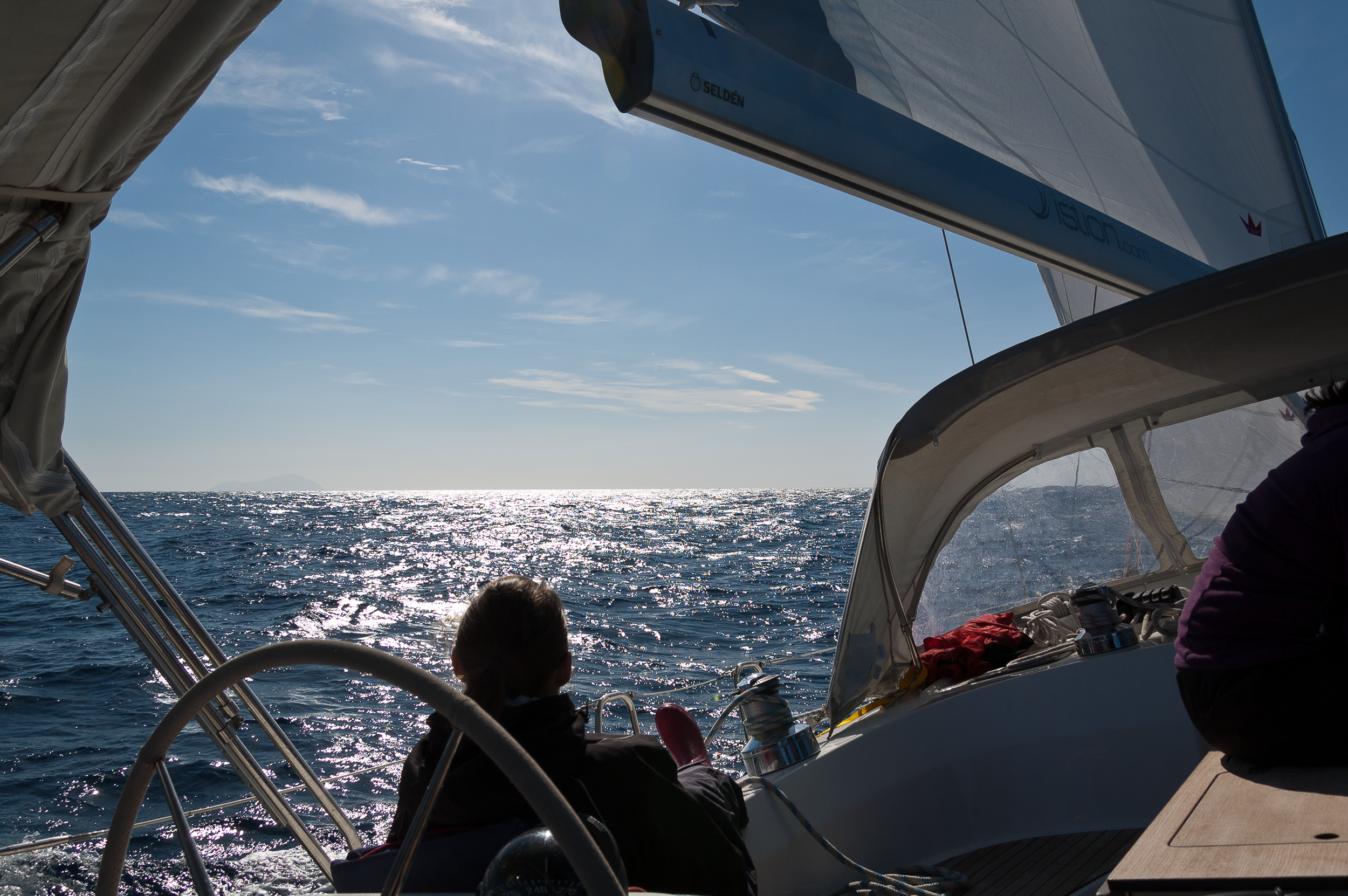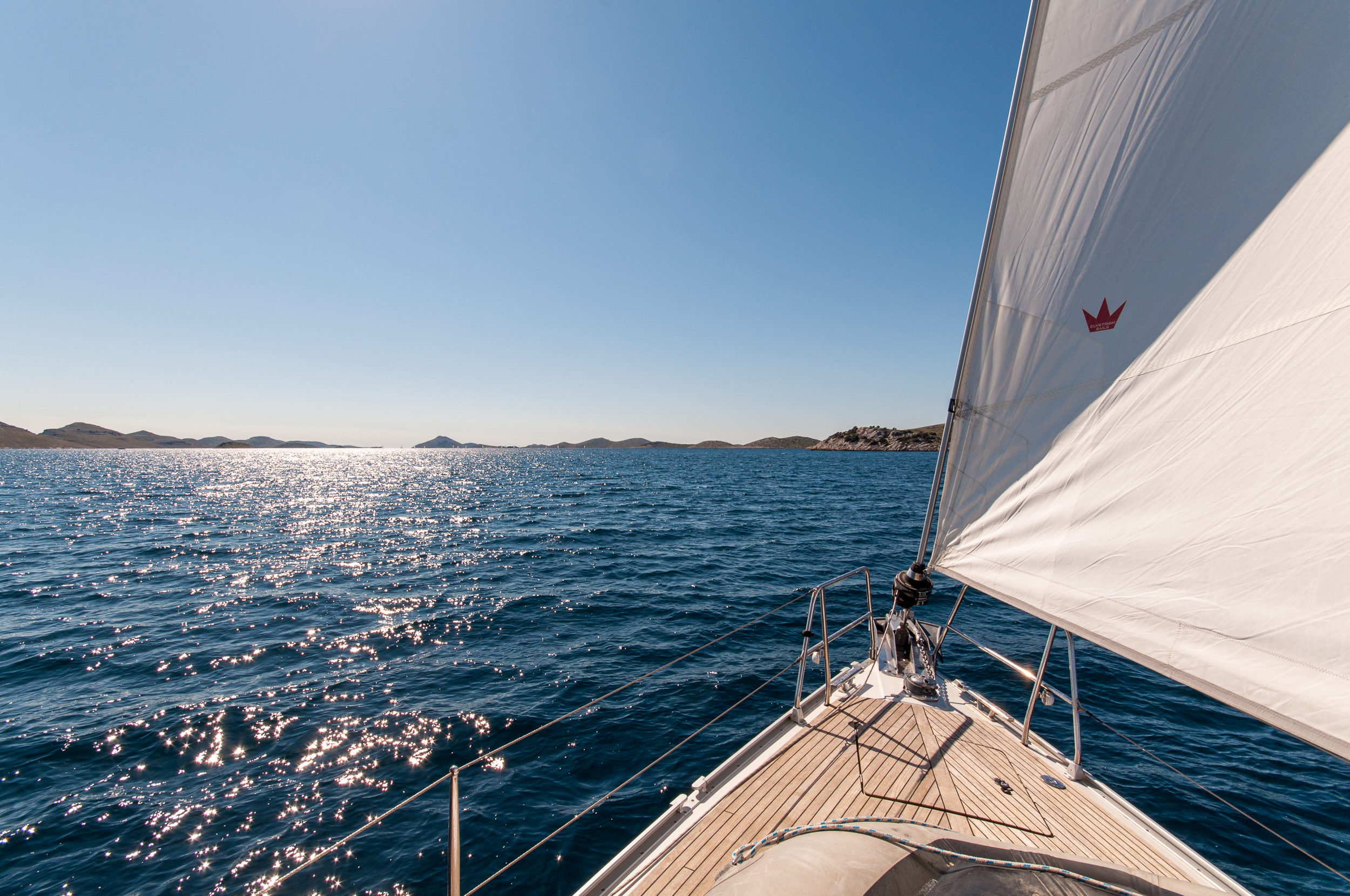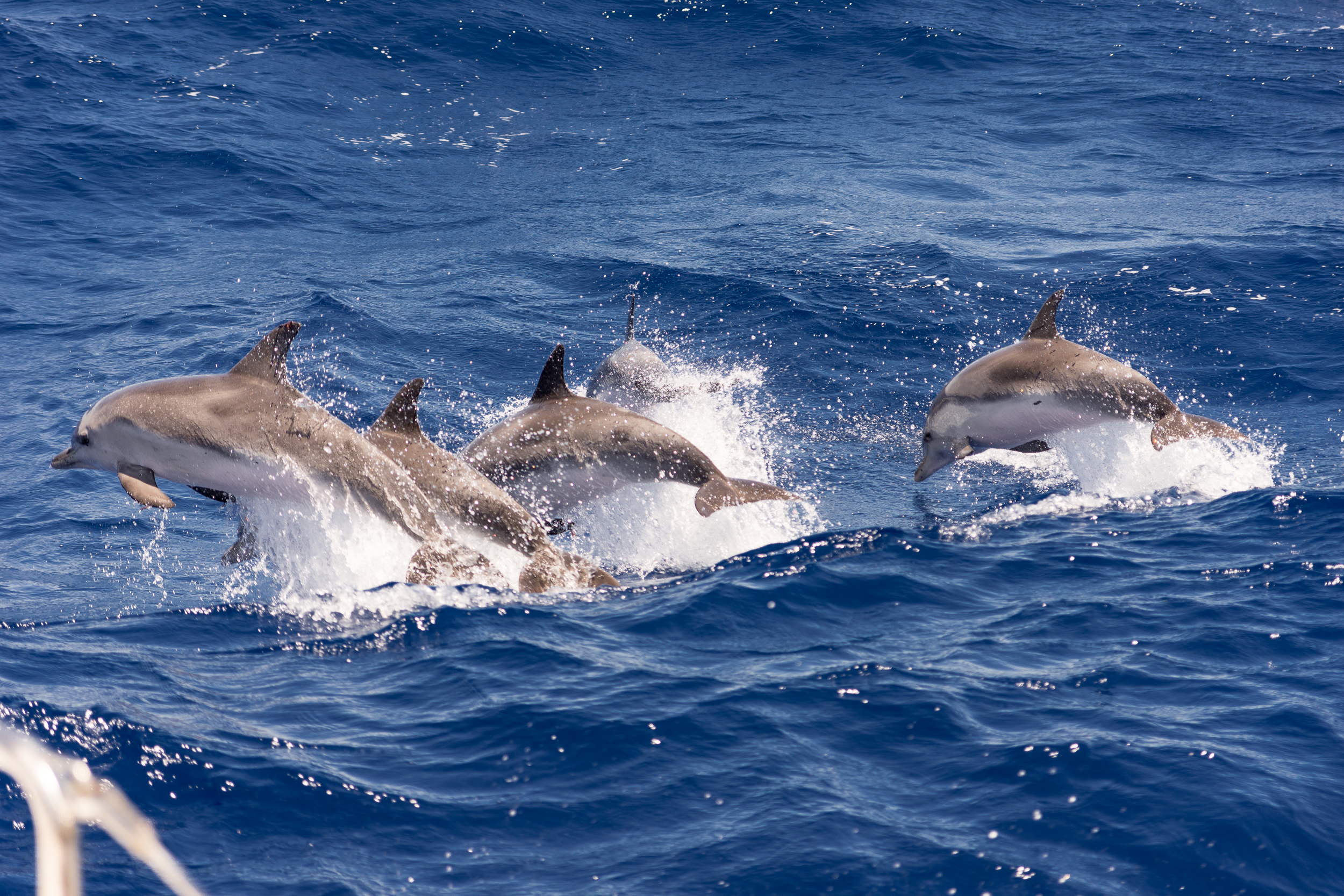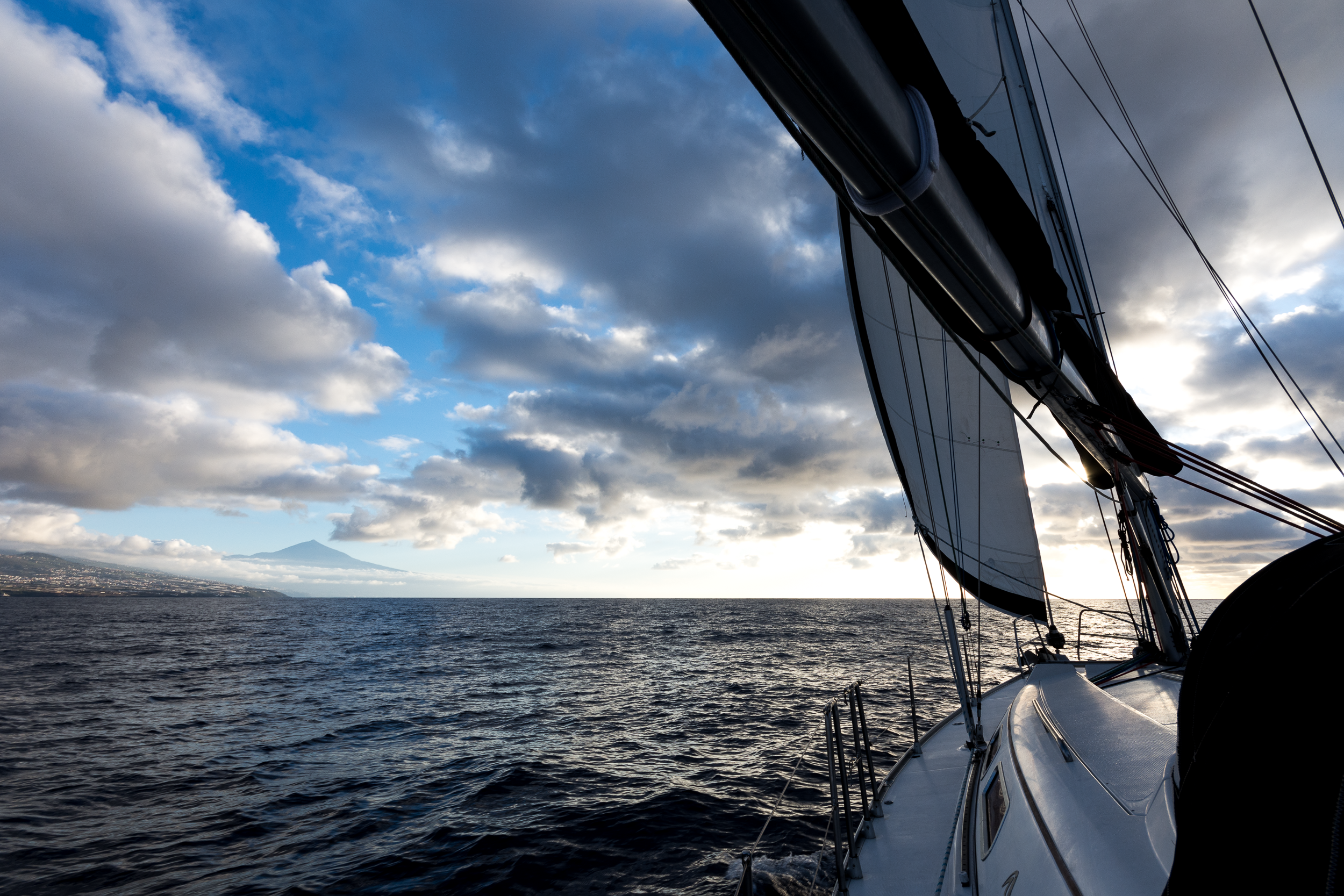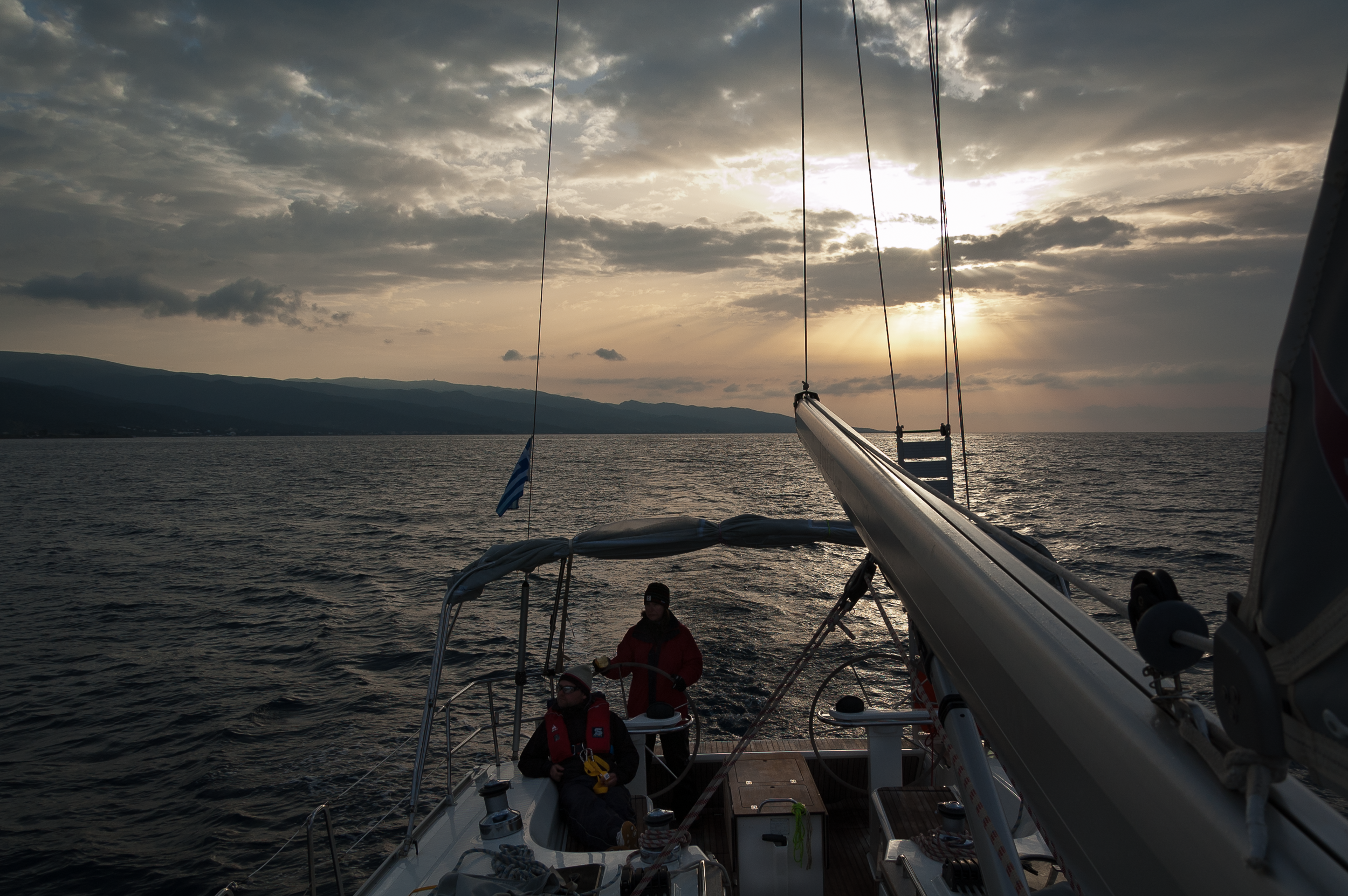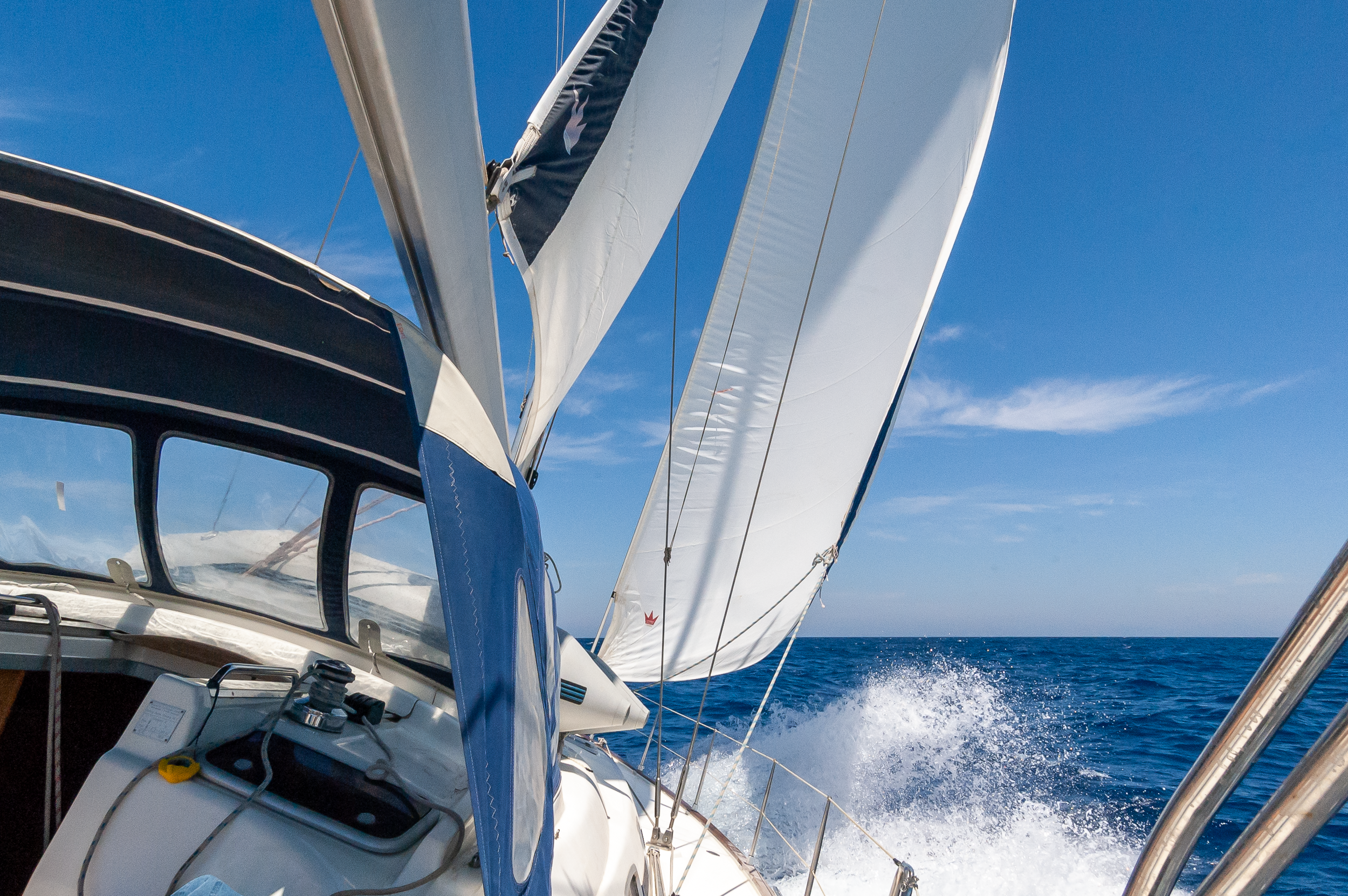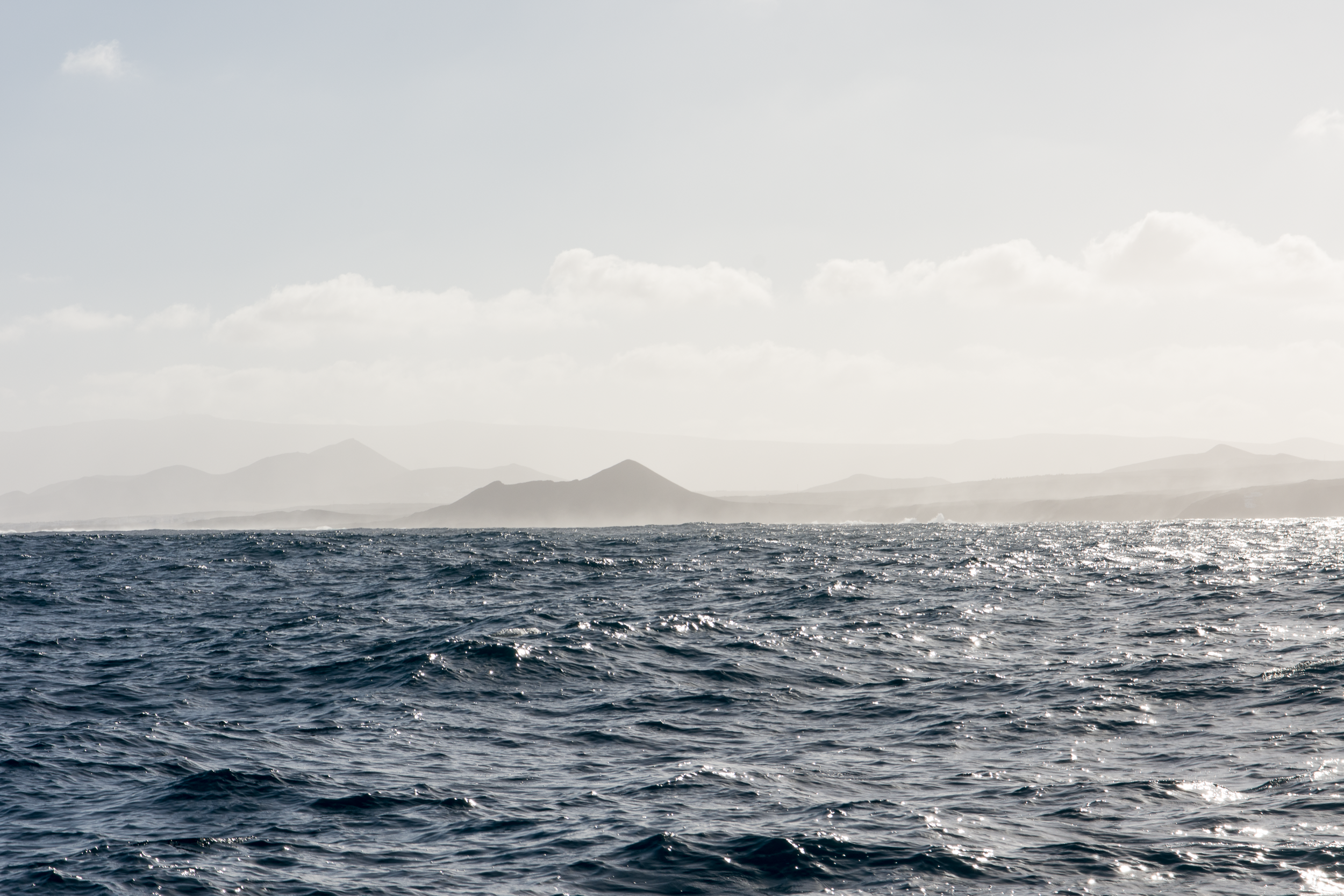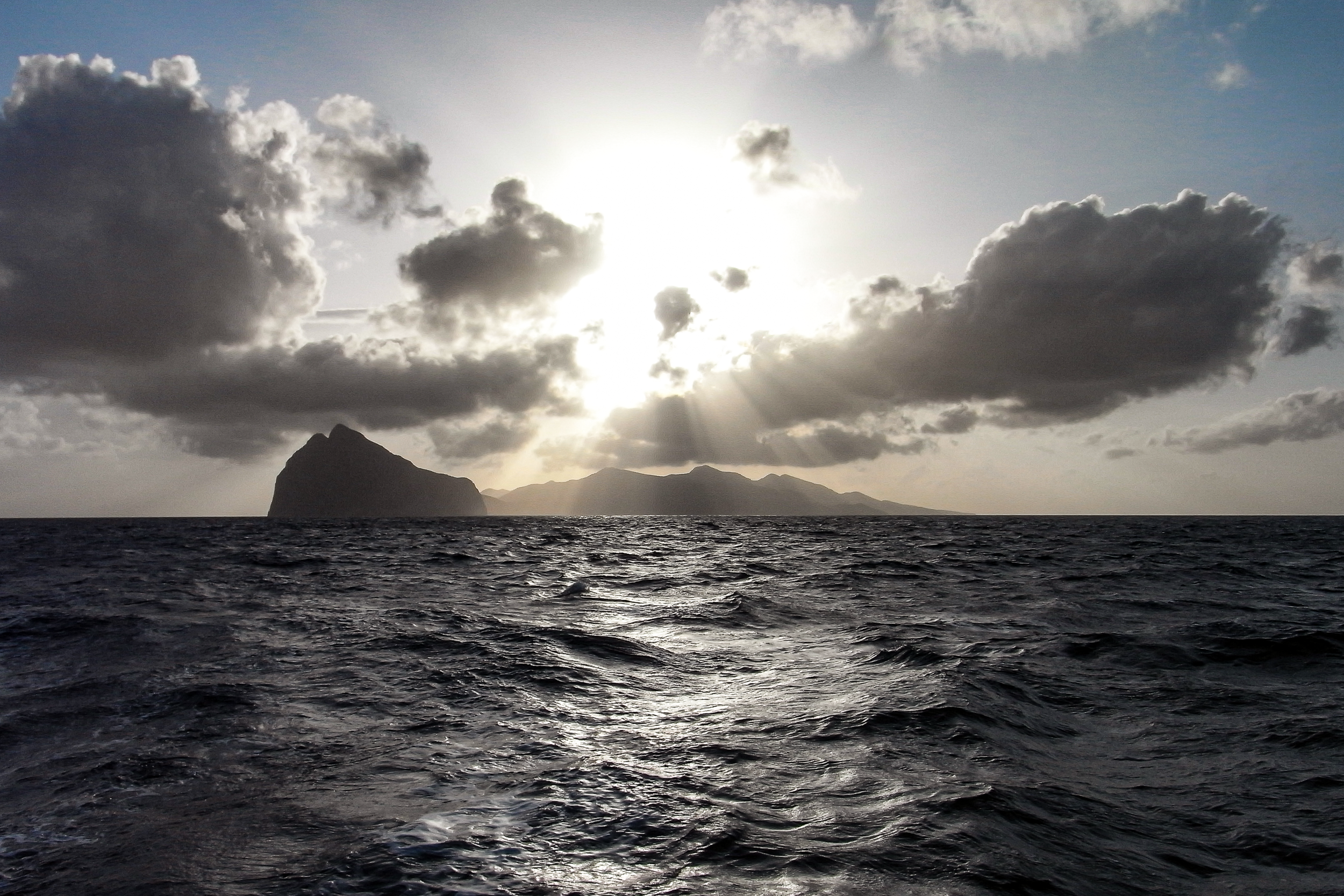Wozu
What For
Der Besitz einer seegängigen Segelyacht suggeriert Luxus und Reichtum. Unsere pepperbird, eine 9m-Yacht aus dem Jahr 1988, hat so viel wie ein Mittelklasse-Wagen gekostet. Um 2.000,00 € im Jahr hat sie einen dauernden Liegeplatz und die notwendigen Anschaffungen und Reparaturen
– okay – reden wir von etwas anderem!
Owning a seagoing sailing yacht suggests luxury and wealth. Our pepperbird, a 9-m yacht built in 1988, cost as much as a middle-class car. At €2,000.00 a year, she has a permanent berth and the necessary purchases and repairs – okay – let’s talk about something else!
Kleine Philosophie des Yachtsegelns
Little Philosophy of Yacht Sailing
Wenn wir also die nüchterne ökonomische Seite der Sache einmal beiseitelassen, stellt sich doch die Frage: Wozu der ganze Aufwand? Was ist es denn, das die Faszination des Yachtsegelns am Meer ausmacht? Was hast du denn von den fast 20-mal vierzehn Tagen an Bord von Charteryachten und bisher neun Wochen an Bord des eigenen Bootes? Wozu plant man für die herannahende Pension ein Leben auf einem schwimmenden Wohnmobil?
Ich denke, es gibt auf diese Fragen mindestens so viele verschiedene Antworten wie es Yacht-Segler*innen gibt. Auf den nächsten Zeilen möchte ich versuchen, meine Antwort darauf zu skizzieren:
Eine der ersten Assoziationen zu einer (privaten) Segelyacht – neben dem „Hauch von Luxus“, der damit verbunden ist – ist die der „grenzenlosen Freiheit“. Und es stimmt: mit einer gut gepflegten und wohl ausgerüsteten Yacht kann ich nahezu jederzeit nahezu jeden beliebigen Hafen an den Ozeanen dieser Welt ansteuern. Sobald ich über meine Lebenszeit frei verfügen kann, kann ich mit einer seegängigen Yacht die Welt umrunden, wenn ich wollte, sogar ganz allein
(ich möchte aber nicht!).
If we leave aside the sober economic side of the matter, the question arises: Why all the effort? What is it that makes yacht sailing at sea so fascinating? What have you got out of spending almost 20 fortnights on board charter yachts and (so far) nine weeks on board your own boat? What is the point of planning a life on a floating caravan for the approaching retirement?
I think there are at least as many different answers to these questions as there are yacht sailors. On the next few lines, I would like to try to sketch out my answer:
One of the first associations with a (private) sailing yacht – besides the „touch of luxury“ connected with it – is that of „boundless freedom“. And it’s true: with a well-maintained and well-equipped yacht, I can sail to almost any port on the oceans of this world at almost any time. As soon as I can freely dispose of my lifetime, I could circumnavigate the world with a seagoing yacht, if I wanted to, even all by myself
(but I don’t want to!).
Ein weiterer Aspekt der Freiheit besteht in dem Fakt, dass es am Wasser keine Straßen gibt. Das heißt, es gibt – bis auf ganz wenige Ausnahmen – keine Einschränkung auf der Wasseroberfläche, die mich zwingen könnte, 500 m weiter rechts oder links von meinem Kurs zu fahren. Ich kann mein Ziel direkt, in Schleifen, in Slalomkurven, gerade oder im Zickzack ansteuern, da redet mir – außer den Crewmitgliedern – niemand drein. Ja, ich kann es mir noch am Anlegesteg der Marina überlegen, wieder auslaufen und doch zu einer anderen Insel fahren. Solange ich mit meiner Ausrüstung und mit meinem Proviant autark bin, werden die Entscheidungen über den zu steuernden Kurs an Bord und nur an Bord getroffen. Sobald die Leinen losgeworfen sind und sobald zwischen dem Boot und dem Rest der Weltbevölkerung ein ausreichender Abstand hergestellt wurde, bestimmen die Regeln des Zusammenlebens die Menschen an Bord und niemand sonst. Wo sonst findet man dieses Ausmaß an Autonomie? Wer sollte mir zwischen Santorini und Kreta vorschreiben, wie laut ich Musik spielen darf? Welchen Dresscode kann wer von mir verlangen, wenn ich gerade von Tenerife nach Madeira unterwegs bin? Was mich auf Fahrt beeinflussen kann, sind die Witterung und die Einflüsse, die Natur und Technik sonst noch auf unser Dasein haben. Eine leergeladene Batterie wird meinen Lebensstil beeinträchtigen (aus ist’s mit der Musik!); nachlassender Wind bestimmt meine Reisegeschwindigkeit; ein fast leerer Tank kann die Wahl meines Reisezieles entscheidend beeinflussen.
Another aspect of freedom is the fact that there are no roads on the water. This means that – with very few exceptions – there is no restriction on the water’s surface that could force me to sail 500 m to the right or left of my course. I can head for my destination directly, in loops, in slalom curves, straight or zigzagging, with no one but the crew members discussing with me what to do. Yes, I can still change my mind at the jetty of the marina, leave the place again and sail to another island after all. As long as I am self-sufficient with my equipment and provisions, the decisions about the course to steer are made on board and only on board. As soon as the mooring lines are cast off and as soon as a sufficient distance has been established between the boat and the rest of the world’s population, the rules of living together are determined by the people on board and no one else. Where else can you find this degree of autonomy? Who should tell me how loud I can play music between Santorini and Crete? What dress code can anyone demand of me when I’m on my way from Tenerife to Madeira? What can influence me underway are the weather and the other impacts that nature and technology have on our existence. An empty battery will affect my lifestyle (that’s it for the music!); decreasing wind determines my cruising speed; an almost empty tank can decisively influence my choice of destination.
Außer den Einschränkungen durch Natur, Technik und materielle Vorratsgüter scheint meine Freiheit an Bord eines entsprechend ausgestatteten Segelboots also unbeschränkt. Das ist eine der schönsten Illusionen, die mit der Seefahrt verbunden sind. Die Kehrseite dieser Freiheit ist nämlich eine schier unvorstellbare Eingrenzung: Ein Boot auf dem Meer ist ein Gefängnis, die jeden Hochsicherheitstrakt einer Strafanstalt in den Schatten stellt. Meine Zelle (im Fall der pepperbird circa neun mal drei Meter) kann ich nämlich ohne Lebensgefahr nicht einen Augenblick verlassen. Ja, ich werde mich sogar mit starken Leinen an diese Zelle anbinden, wenn ich aus dem Cockpit einmal raus muss, damit ich nicht unfreiwillig im großen Ozean verloren gehe. Es gibt für den Menschen keine lebensfeindlicheren Bedingungen als inmitten der großen Salzwüsten der Ozeane. Was ich nicht dabei habe, werde ich dort nicht finden. Das Land, das manche in der Not für ein rettendes Ufer halten könnten, ist in sehr vielen Fällen eine noch größere Gefahr als die offene See. Als wir 2018 nächtens bei 25 Knoten Wind an der Nordküste Gran Canarias entlang segelten, habe ich versucht mir auszurechnen, was bei einer plötzlichen Manövrierunfähigkeit der Yacht wohl schneller sei: unsere Abdrift in Richtung der Klippen der Insel oder die Rettungsmannschaften der Küstenwache. Ich bin dann noch ein paar Grade höher am Wind gefahren, um noch ein paar Kabellängen mehr Seeraum zu gewinnen!
Das aber ist für mich gerade das Faszinierende daran: Der Idee der hochgradigen persönlichen Autonomie steht eine hochgradige Beschränkung auf den Lebensraum „Yacht“ gegenüber. Das eine ist ohne das andere nicht zu haben. Letztlich ist aber das Gefühl der Freiheit vorherrschend, weil das Moment des Eingeschränkt-Seins doch nur ein vorübergehendes ist.
Apart from the restrictions imposed by nature, technology and material supplies, my freedom on board a suitably equipped sailing boat thus seems unlimited. This is one of the most beautiful illusions associated with seafaring. The flip side of this freedom is, in fact, an almost unimaginable degree of restriction: a boat at sea is a prison that dwarfs any high-security wing of a penal institution. I cannot leave my cell (in the case of the pepperbird, about nine by three metres) for a moment without risking my life. Yes, I will even tie myself to this cell with strong lines when leaving the cockpit so that I don’t get involuntarily lost in the great ocean. There are no conditions more hostile to human life than in the midst of the great salty deserts of the seas. What I do not have with me, I will not find there. The land, which some might think of as a saving shore in times of need, is in very many cases an even greater danger than the open sea. In 2018, when we sailed along the north coast of Gran Canaria at night in 25 knots of wind, I tried to calculate what would be faster if the yacht suddenly became unable to manoeuvre: our drift towards the cliffs of the island or the rescue teams of the coastguard. I then sailed a few degrees closer to the wind to gain a few more cable lengths of sea room!
But that’s what’s fascinating about it for me: the idea of a high degree of personal autonomy is contrasted with a high degree of confinement to the habitat “sailing yacht”. You can’t have one without the other. Ultimately, however, the feeling of freedom is predominant because the moment of being restricted is only a temporary one.
Aber ist das nicht gefährlich? Diese Frage wird einem oft gestellt, wenn man erzählt, dass man gerne mit kleinen Booten weite Strecken übers Meer fährt. Potenziell ist so eine Seefahrt natürlich „auch“ gefährlich. Aber sicher viel weniger als eine mehrstündige Fahrt auf einer europäischen Autobahn. Solange der Schiffsrumpf intakt ist, beide Antriebe funktionieren, das Ruder für Manövrierfähigkeit sorgt und die Mittel zur Bestimmung von Position, Richtung und Geschwindigkeit nicht versagen, kann praktisch nichts passieren. Der Vorteil einer kleinen nicht zu modernen Yacht besteht unter anderem darin, dass ziemlich viele potenzielle Schäden mit Bordmitteln während der Fahrt behoben werden können – ausreichend Wissen und Können vorausgesetzt. Von welchem modernen Kraftwagen kann das ebenfalls gesagt werden?
Wie schon gesagt, das Meer ist eine lebensfeindliche Wüste und wirklich gefährlich ist es an Bord kaum, abseits davon sehr wohl. Wir werden also dafür Sorge tragen, dass niemand während der Fahrt unfreiwillig aussteigt, getreu dem Motto: „Das beste ‚Mensch-über-Bord-Manöver‘ besteht darin, dass alle stets binnenbords bleiben!“
Aber die Stürme!? – Die sind natürlich zu vermeiden. Heutzutage sind extreme Wetterlagen recht gut vorhersehbar, zumindest für ein paar Tage im Voraus. Mittels Satelliten-Verbindung stehen die entsprechenden Daten jederzeit weltweit zur Verfügung – ausreichend Strom in den Batterien vorausgesetzt. Wenn man dann noch ausreichend Zeit hat, für die jeweilige Strecke ein günstiges „Wetterfenster“ abzuwarten, droht von dieser Seite kaum noch Ungemach. Wir müssen also zu unseren Sicherheitseinrichtungen (dichter Rumpf, doppelter Antrieb, Manövrierfähigkeit, sichere Navigation) noch das Funktionieren der Bordelektronik zählen. Die Sache wird dann doch ganz schön komplex, wenn sie sicher sein soll. Aber vergessen wir nicht: Was brauchte denn der alte Kolumbus, um von Palos de La Frontera nach den Bahamas zu segeln? Am Ende reduziert sich die Essenz des Yachtsegelns auf den dichten Rumpf, das funktionierende Rigg, eine intakte Steuerung und das Können der Besatzung –
und gutes Essen und Trinken, um diese bei Laune zu halten!
But isn’t that dangerous? This question is often asked when you tell people that you like to travel long distances across the sea in small boats. Of course, such a sea journey is potentially „also“ dangerous, but certainly much less so than a journey of several hours on an European motorway. As long as the hull is intact, both means of propulsion are working, the rudder provides manoeuvrability and the means for determining position, direction and speed do not fail, practically nothing can happen. The advantage of a small yacht that is not too modern is, among other things, that quite a lot of potential damage can be repaired with on-board means during the journey – sufficient knowledge and skill provided. Of which modern motor vehicle can this also be said?
As already outlined, the sea is a hostile desert and it is hardly really dangerous on board the boat, away from it very much so. So, we will make sure that no one gets out involuntarily during the journey, true to the motto: „The best ‚man overboard manoeuvre‘ is for everyone to stay inboard at all times!“
But the storms!? – Those are to be avoided, of course. Nowadays, extreme weather conditions can be predicted quite well, at least a few days in advance. By means of a satellite communication, the corresponding data is available worldwide at any time – provided there is sufficient power in the batteries. If you then have enough time to wait for a favourable „weather window“ for the respective route, there is hardly any threat of mischief from that side. So, we have to add to our safety equipment (intact hull, double propulsion, manoeuvrability, safe navigation) the functioning of the on-board electronics. In the end, this whole affair becomes quite complex if it is to be safe. But let’s not forget: what did old Columbus need to sail from Palos de La Frontera to the Bahamas? In the end, the essence of yacht sailing boils down to a sealed hull, a functioning rig, intact steering, and the skill of the crew – and good food and drink to keep them in good moods!
Und damit wären wir bei der Hauptsache: dem Segeln!
And that brings us to the main thing: sailing!
Es ist eine sternenklare Nacht. Wir fahren auf Am-Wind-Kurs mit einer frischen Brise von vier bis fünf Windstärken. Ich bin alleine im Cockpit. Vor mir glimmt dunkelrot die Kompassbeleuchtung. Im geisterhaften Licht der Sterne sind die dunklen Umrisse von ein, zwei Inseln gerade noch sichtbar. Ich weiß, dass wir noch bis morgen Abend zu fahren haben, bevor wir an unser Ziel kommen. Vor mir liegen ein paar Stunden, in denen nichts anderes zählt als den Kurs zu halten und auf jede Änderung des Windes mit den entsprechenden Manövern zu reagieren. Unten ruhen sich drei Leute aus, die ich sofort holen kann, wenn sie für Segelmanöver gebraucht werden. Aber die laufenden Korrekturen am Steuer genügen vorläufig, um das Boot auf Kurs zu halten. Die Bewegungen der Wellen, meine Reaktionen am Ruder, die gelegentlichen Böen – aus bewussten Tätigkeiten werden mit der Zeit automatische Vorgänge. Ich fühle, wie meine Augen, die den Kompass kontrollieren, meine Wangen, die den Wind spüren und meine Muskeln, die die Ruderstellung immer wieder leicht anpassen, sich langsam auf das System aus den Strömungen von Luft und Wasser an Segeln und Unterwasserschiff einkoppeln. Dazu kommt der undurchschaubare und doch fast regelmäßige Rhythmus der Wellen, der sich über die Bank, auf der ich sitze, ebenfalls auf meinen Körper überträgt. Irgendwann braucht es für die Steuerung des Bootes keiner bewussten Denkleistung mehr, meine Sinne und mein Körper wissen, was sie zu tun haben. –
Wäre ich Faust, DAS wäre der Augenblick!
It is a starry night. We are sailing on a close reach with a fresh breeze of four to five Beaufort. I am alone in the cockpit. The compass light is glowing dark red in front of me. In the ghostly light of the stars, the dark outlines of one or two islands are just visible. I know we still have to sail until tomorrow evening before we reach our destination. I have a few hours at the helm ahead of me in which nothing else matters but holding the course and reacting to every change in the wind with the appropriate manoeuvres. Down below, three people are resting, and I can fetch them immediately if they are needed for sailing manoeuvres. But the ongoing corrections at the helm are enough for the time being to keep the boat on course. The movements of the waves, my reactions at the helm, the occasional gusts – conscious activities become automatic processes over time. I feel my eyes controlling the compass, my cheeks sensing the wind and my muscles adjusting the rudder position ever so slightly, slowly coupling with the system of currents of air and water on the sails and underwater hull. Add to this the inscrutable yet almost regular rhythm of the waves, which is also transmitted to my body via the bench on which I sit. At some point, steering the boat no longer requires any conscious thought; my senses and my body know what they have to do. –
If I were Faust, THAT would be the moment!
Das ist der Augenblick, an dem die Gedanken loslassen können. Es existieren – für den Augenblick – keine Probleme, es gibt keine Aufgaben, es muss nichts gelöst, gut gemacht, hergestellt werden. Die Zukunft, das ist die nächste Welle, die mit einem kurzen Anluven ausgeglichen wird. Unterbrochen werden diese meditativen Momente gelegentlich durch Zwischenfälle, die mich wieder zurück auf die materielle Welt holen: Was ist das dort drüben für ein Fahrzeug? Welchen Kurs steuert es, wird es unseren Kurs kreuzen? Wird von mir/uns ein Manöver notwendig werden? Wann muss ich mit der Vorbereitung beginnen? Hole ich Robert, der gerade „Backup“ ist, ins Cockpit, oder lasse ich ihn noch schlafen? Unsere Bewegung ist so langsam, dass 15 Minuten vergehen, bis klar wird, dass wir von dem anderen Fahrzeug nicht beeinflusst werden und ich falle gemächlich wieder zurück in den „automatischen Modus“. Ein andermal ist es eine Schule von Delfinen, die unseren Kurs kreuzen und im Licht des vor kurzem aufgegangenen Mondes ihre Spuren durch das glitzernde Wasser ziehen. Gibt es ein friedlicheres Bild als dieses?
That is the moment when thoughts can let go. There are – for the moment – no problems, there are no tasks, nothing needs to be solved, made good, produced. The future, that is the next wave, which is balanced with a short correction to windward. These meditative moments are occasionally interrupted by incidents that bring me back to the material world: What kind of vessel is that over there? What course is it steering, will it cross our course? Will a manoeuvre become necessary on my/our part? When do I have to start preparing? Do I call Robert, who is currently „backup“, into the cockpit, or do I still let him sleep? Our movement is so slow that 15 minutes pass before it becomes obvious that we are not affected by the other ship, and I leisurely fall back into „automatic mode“. Another time it is a school of dolphins crossing our course, making their traces through the glistening water in the light of the recently risen moon. Can there be a more peaceful image than this?
Tagsüber schaut die Sache natürlich anders aus: Das Cockpit ist voller Leute, es wird geplaudert, gescherzt, gelacht. Während ein entspannter Tag ohne belastende Verpflichtungen abläuft, werden Wind, Wellen, Segel usw. von den zuständigen Leuten beobachtet und bedient. Manchmal kommen Diskussionen zur wünschenswerten Vorgangsweise auf, Einschätzungen werden ausgetauscht, Optionen werden gesammelt, Wissen wird geteilt. Am Ende entscheidet der Skipper – seit 2008 bin das immer ich – aber der kann sich ja auch überzeugen lassen (muss aber nicht). Da ich mein Leben lang gewohnt bin, Verantwortung zu übernehmen, belastet mich die Rolle des Schiffsführers kaum und nachdem am Ende eines Törns noch niemand je gesagt hat: „Nein, mit dir fahre ich bestimmt kein zweites Mal!“, scheine ich meine nautische Führungsrolle auch für die anderen einigermaßen erträglich zu gestalten.
During the day, of course, things look different: The cockpit is full of people, chatting, joking, laughing. While a relaxed day passes without burdening obligations, the wind, waves, sails, course etc. are observed and operated by the people in charge. Sometimes discussions arise about the desirable course of action, assessments are exchanged, options are collected, knowledge is shared. In the end, the skipper decides – since 2008 it has always been me – but he can be convinced (but doesn’t have to be). Since I’ve been used to taking responsibility all my life, the role of skipper is hardly a burden for me, and since no one has ever said at the end of a trip: „No, I’m definitely not going to sail with you a second time!“, I seem to make my role in the nautical leadership somewhat bearable for the others as well.
Sehr viel Spaß macht es auch, einen Törn zu planen, mich über die Bedingungen des Fahrtgebiets zu orientieren, Ausweichrouten zu entwickeln und passende Häfen zu finden. Zwar ist es mir erst ein einziges Mal gelungen, den zuvor erstellten Plan dann auch in einer Fahrtroute umzusetzen, aber ich wusste auch immer um alternative Optionen, so dass wir stets auch auf den improvisierten Routen schöne Reisen erlebten.
Auch die Navigation fällt mir leicht und macht mir große Freude. Zwar hat diese Kunst viel von ihrem Charme verloren, seit es mit GPS und Kartenplottern sehr einfach geworden ist, ans Ziel zu finden. Da wir aber wissen, dass elektrische Energie auch ausfallen kann, ist es gut zu wissen, wie man einen Kurs koppelt oder eine Kreuzpeilung vornimmt. Ich bin daher zuversichtlich, dass ich in einem Gebiet wie etwa der Ost-Ägäis auch ohne Elektronik sicher meine Häfen und Ankerbuchten finden würde. Auch einen Sextanten nenne ich mein Eigen, und in der Theorie ist mir die Astronavigation geläufig, da es bisher allerdings nicht notwendig war, den Standort aus einem Sonnenwinkel abzuleiten, habe ich es wieder aufgegeben, Auszüge aus dem nautischen Almanach mit an Bord zu nehmen.
It’s also a lot of fun to plan a trip, to find out about the conditions in the sailing area, to develop alternative routes and to find suitable ports. Although I have only once succeeded in implementing the plan I drew up beforehand in a sailing route, I was always aware of alternative options, so that we always had nice trips even on the improvised routes.
Navigation is also easy for me and gives me great pleasure. Admittedly, this art has lost much of its charm since GPS and chart-plotters have made it very easy to find your way to your destination. But since we know that electrical power can also fail, it is good to know how to calculate a dead reckoning or take a cross bearing. I am therefore confident that in an area such as the Eastern Aegean I would be able to find my harbours and anchorages safely even without electronics. I have also a sextant, and in theory I am familiar with astronavigation, but since it has not been necessary so far to derive a position from an angle of the sun, I have given up taking extracts from the nautical almanac on board.
Die Liste der Tätigkeiten und Erlebnisse auf einer seegängigen Yacht ließen sich noch sehr lange fortsetzen. Ich denke aber, dass mein Spaß an der Sache inzwischen hinreichend klar geworden sein dürfte. Wenn der Spaß nachvollziehbar ist und Neugierde geweckt werden konnte, so zögere nicht, geneigte Leserin, aufmerksamer Leser, sondern nütze die erste sich bietende Gelegenheit und probiere es selber aus!
The list of activities and experiences on a seagoing yacht could be continued for a very long time. However, I think that my enjoyment of the matter should have become sufficiently clear by now. If the fun is comprehensible and curiosity has been aroused, do not hesitate, dear reader, but take the first opportunity that presents itself and try it out for yourself!


